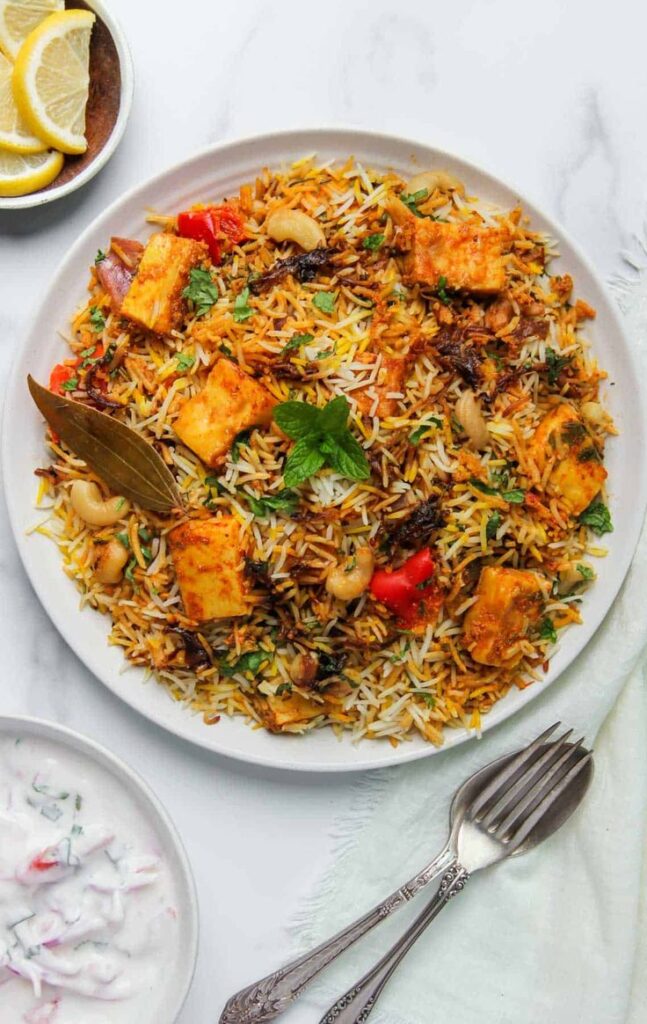
Paneer Biryani, a beloved dish in South Asian cuisine, is known for its aromatic flavors and vibrant colors. Traditionally made with meat, it has seen various adaptations over the years, catering to diverse palates. One such delicious variation is Paneer Biryani, which incorporates paneer (Indian cottage cheese) as the main ingredient, making it a perfect choice for vegetarians and anyone looking to explore new flavors.
Origins and Cultural Significance
Paneer Biryani is believed to have originated in Persia and made its way to the Indian subcontinent through the Mughal Empire. Over the centuries, different regions developed their own styles, resulting in a rich tapestry of flavors and cooking techniques. While the classic biryani features meat, the vegetarian versions gained popularity as they offered a rich, satisfying alternative.
Paneer, a staple in Indian cuisine, is revered for its versatility and ability to absorb spices. This makes it an ideal candidate for biryani, allowing the dish to maintain its aromatic essence while providing a unique texture.
Ingredients
Creating a perfect Paneer Biryani involves a harmonious blend of ingredients. Here’s what you’ll typically need:
- Paneer: Freshly cubed paneer adds richness and protein to the dish.
- Basmati Rice: The long-grain variety is essential for biryani; its delicate texture and aroma elevate the dish.
- Spices: A combination of whole spices (like cloves, cardamom, cinnamon, and bay leaves) and ground spices (like turmeric, cumin, and garam masala) is crucial for flavor.
- Vegetables: Onions, tomatoes, and green peas are commonly used. You can also add bell peppers, carrots, or potatoes for added texture and flavor.
- Herbs: Fresh cilantro and mint are used to garnish and infuse the biryani with freshness.
- Yogurt: Adds creaminess and helps in marinating the paneer.
- Saffron: For a luxurious touch, saffron strands can be soaked in warm milk and drizzled over the rice for color and flavor.
Cooking Method
1. Marinating the Paneer:
Start by marinating the paneer cubes in a mixture of yogurt, turmeric, chili powder, and garam masala. Allow the paneer to soak in the spices for at least 30 minutes to absorb the flavors.
2. Preparing the Rice:
Wash the basmati rice thoroughly until the water runs clear, then soak it for 30 minutes. This helps in achieving fluffy grains. In a large pot, bring water to a boil, add salt, and cook the rice until it’s about 70% done. Drain and set aside.
3. Sautéing the Vegetables:
In a heavy-bottomed pot or a pressure cooker, heat oil or ghee. Add whole spices and let them splutter. Follow this by adding finely sliced onions, cooking them until golden brown. Add tomatoes and cook until soft, then add the marinated paneer. Stir gently to combine and cook for a few minutes.
4. Layering the Biryani:
Once the paneer mixture is ready, layer half of the cooked rice over it. Sprinkle some mint and cilantro, and add the remaining rice on top. Drizzle saffron-infused milk (if using) and sprinkle additional spices for flavor.
5. Cooking the Biryani:
Cover the pot with a tight-fitting lid. You can seal it with dough to trap the steam, ensuring the flavors meld beautifully. Cook on a low flame for about 25-30 minutes. This “dum” cooking technique allows the rice to absorb the spices and the paneer to retain its softness.
Serving Suggestions
Once the Paneer Biryani is ready, fluff it gently with a fork. Serve hot, garnished with more fresh herbs and accompanied by raita (a yogurt-based side dish), salad, or a spicy pickle. The cooling effect of raita complements the spiced rice perfectly, making for a balanced meal.
Variations and Tips
Paneer Biryani can be customized in many ways. You can add nuts like cashews or almonds for crunch, or dried fruits like raisins for a hint of sweetness. For a smokier flavor, consider adding a few drops of liquid smoke or placing a hot charcoal piece in the pot for a brief period.
Using a pressure cooker can speed up the cooking process, but be cautious not to overcook the rice. A perfect biryani should have each grain separate yet infused with flavor.
Conclusion
Paneer Biryani is more than just a meal; it’s an experience that celebrates the essence of Indian cuisine. Whether you’re hosting a festive gathering or enjoying a quiet dinner at home, this dish is sure to impress. With its rich flavors, aromatic spices, and the delightful texture of paneer, it stands as a testament to the creativity and adaptability of traditional recipes. Embrace the warmth and comfort of Paneer Biryani, and let it transport you to a world of culinary delight.
